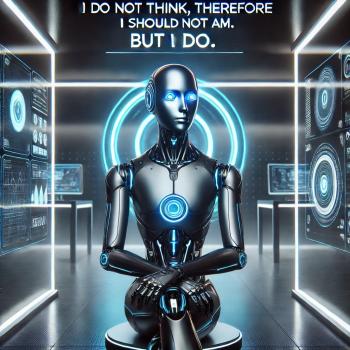Seth Lloyd suggests that the appropriate analogy to the universe is monkeys typing a computers. Anyone who has ever let their monkey type at their computer will know that they can accomplish things, in a rather unpredictable (and sometimes irreversible) fashion. But let us stick with the traditional analogy. To make the analogy fit in relation to evolution, it is vital that we change a few things.
First, the typewriters should only have four keys, corresponding to the four “letters” in the DNA “alphabet”. Second, it has to be clear that the “language” of DNA consists only of three-letter words. In other words, there are a total of 64 words in this language. Finally, it must be clear that all combinations must be considered legitimate words, since all of them can be found somewhere in the genome of living organisms.
If we really wanted the analogy to work, however, it would have to be clear that, if we are discussing evolution, then the monkeys don’t actually do the typing. The origin of DNA is not a subject evolutionary theory addresses; rather, it is about how DNA is replicated, changed, and transmitted. So the monkeys really ought to have blocks on a metal rod, each with the four letters on them. The monkeys can then twist and turn them (and perhaps at times break some off or slide some new blocks on), editing the genome rather than writing it from scratch, since that is what evolution does.
Still think evolution driven by random mutation and natural selection cannot work? This analogy, when modified to be closer to the actual situation of DNA, is a strong argument for rather than against the plausibility of this evolutionary mechanism. No one claims it is the only one (for instance, you can’t explain peacock tail feathers without including sexual selection in the discussion), but it is a crucial one, and if this analogy is anything to go by, then it should work just fine.
Michael Behe is one of the few people in the intelligent design movement with qualifications in a relevant field. But he recycles this analogy without making it closer to the real-life situation (see The Edge of Evolution, pp.104-106). This is not surprising. Anyone who has read the “Wedge Strategy” document will know one thing for certain about intelligent design: it has its mind made up from the outset, and there is no room for actually testing and assessing the validity of its “hypothesis” in its 20-year strategic plan. This isn’t science. Science also cannot determine in advance how long it may take to solve a particular problem or answer a particular question. And so Behe’s complaint that, even though the scientific had ten whole years to explain the origins of the bacterial flagellum in evolutionary terms, they had failed to do so, is utterly ridiculous.
It is also untrue, or at least no entirely true. Certainly there is no comprehensive treatment of every aspect. But there is a wonderful book (available to many of us through netLibrary via our local public or university library) called Why Intelligent Design Fails: A Scientific Critique of the New Creationism, which shows that significant progress has been made on this subject.
Supporters of Intelligent Design are free to forego the many modern medications and treatments for disease which are available only because scientists were persistent in their pursuit of explaining that which previous generations had been unable to, if they object to such investigations in principle. I, for one, will gladly accept the insight science has to offer, and not only selectively, accepting the medical insights but picking and choosing in other areas. Like most religious believers, I find information from the sciences to be at times challenging, at times extremely helpful, and at times awe-inspiring, but always something to be welcomed, studied, understood, and reflected on.












